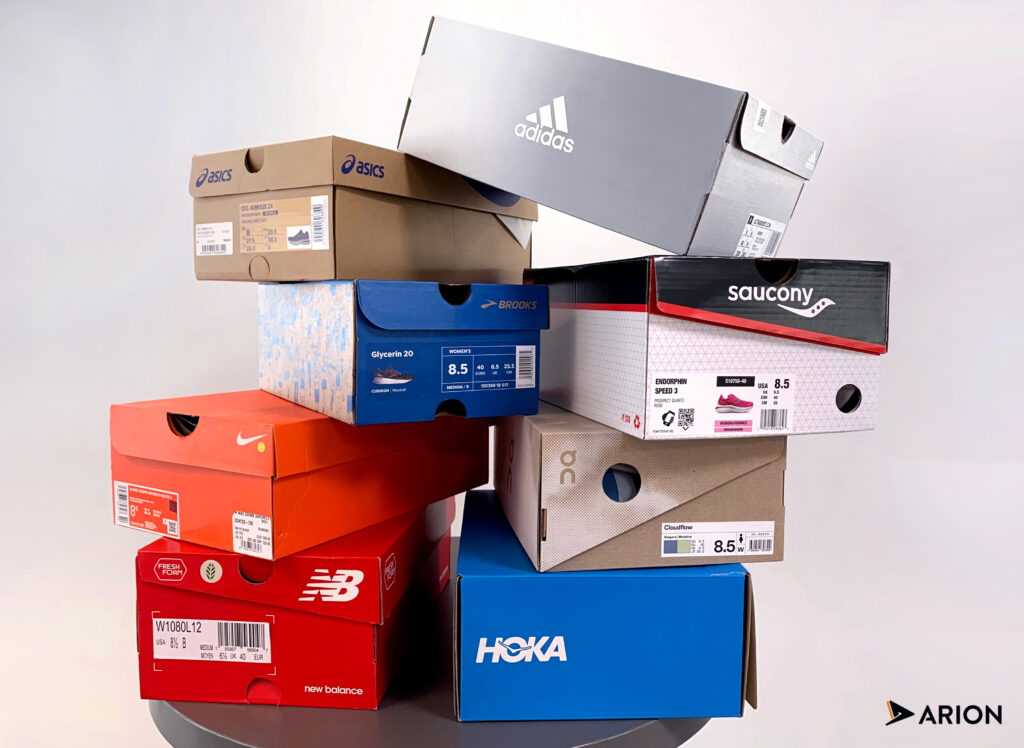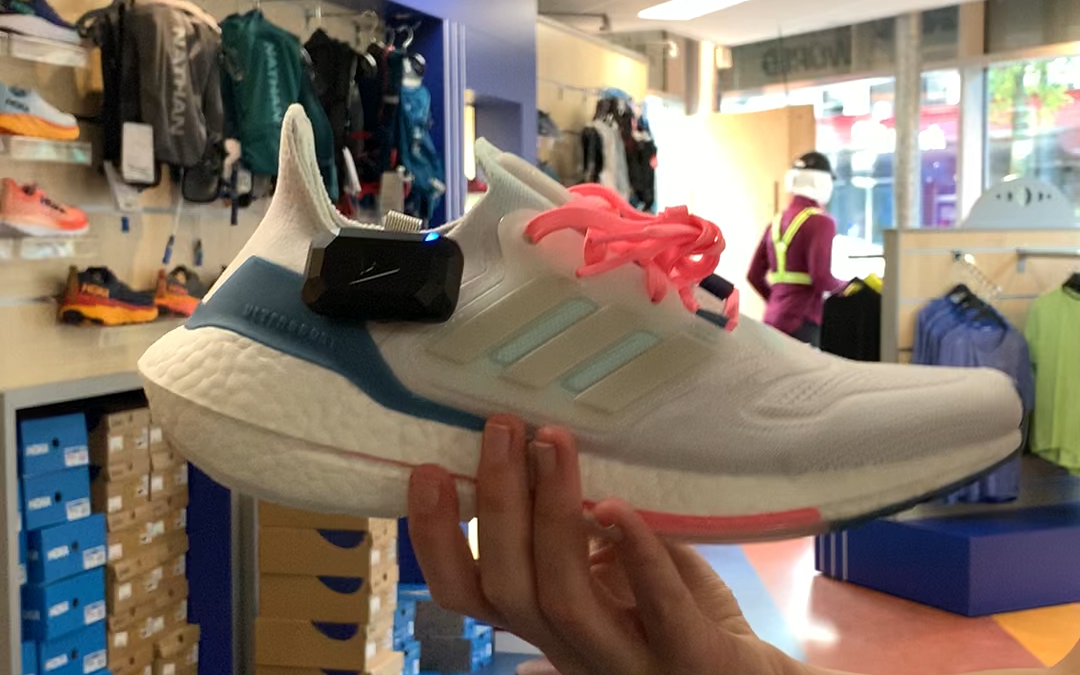At ARION we are on a mission to decode human movement. After a decade of research, six years of operation, and thousands of hours of recorded movement data, one thing has become very clear to us. Movement is exceptionally unique.
We all have our own body types, varied techniques, unique philosophies and personal goals. All of these elements heavily influence the way we move, each contributing to our individual biomechanical profile, which we refer to as, your unique running identity.
To explore this, in this content series we will highlight that there is no such thing as the perfect running shoes. It all depends on your own completely unique biomechanics and your individual goals. We will be testing eight of the latest and greatest running shoes. Utilising our groundbreaking technology shows how one shoe can have two very different results on two very seemingly similar people.

We don’t review the shoes based on their general performance. We simply highlight the diverse results generated across different people. Each month we will put a new pair of shoes to the test before finally reviewing it all together with a final summary of our movement experiment.
As always, it’s the same conditions (treadmill), same shoe, same size, same pace, same distance, very different results! Fifth up is the adidas Ultraboost 22…
adidas Ultraboost 22
The adidas Ultraboost 22 is a neutral running shoe with a heel-to-toe drop of 10mm. The running shoe is known for its responsive BOOST cushioning and an upper that fits like a sock. The BOOST technology has always been known for its energy return.
1. The Runners
Let’s introduce our runners. Runner 1 is Manouk. She runs around once every two weeks for a longer run, and every week a couple of short runs to conduct research for ARION. Her preferred distance is around 5k with a pace between 5:15 and 5:30 min/km. A future goal for Manouk is to finish a quarter triathlon. She likes to run because she wants to stay in shape and doesn’t have time to take part in other sports.
Our second runner, runner 2 is Elzemieke. She runs around three times a week for long runs. Her preferred distance is around 5k with a pace between 6:15 and 6:30 min/km. A short-term goal for Elzemieke is to run a 10k race. Elzemieke likes to run because it clears her mind and to stay in shape.
For both runners, we will compare the adidas Ultraboost 22 to a baseline shoe. This baseline shoe will be an average of how both runners run. For both runners, the baseline shoe is a neutral running shoe with a lower heel-toe drop and stack height (low mid-sole thickness). With this baseline shoe, Manouk is a forefoot lander and Elzemieke is a rearfoot lander. Manouk is neutrally balanced whereas Elzemieke uses her left foot a little more than her right. Both runners have an average cadence for a recreational runner and a relatively high stability profile with little variation in the foot placement with each step.
2. The Results

3. The Insights
Footstrike
Let’s first compare both shoes on their effects at footstrike. Remember that a footstrike of 0% would indicate a foot landing that is as far as possible towards the heel, and a footstrike of 100% indicates the foot lands right at the tip of the toes. In our baseline shoe, we’ve already seen that Elzemieke is a rearfoot lander, landing her foot a little bit away from the back of the heel with a footstrike of 16%. On the other hand, in the exact same baseline shoe, Manouk is very clearly a forefoot lander with a footstrike of 78.2%.
 At 10 mm, the adidas Ultraboost 22 shoe has a relatively high heel-toe drop which often encourages runners to land more towards their heels. For Elzemieke we do indeed see an even more pronounced heel strike with 7.1%. Similarly, Manouk’s footstrike changes more towards a heel strike from 78.2% to 73.5%.
At 10 mm, the adidas Ultraboost 22 shoe has a relatively high heel-toe drop which often encourages runners to land more towards their heels. For Elzemieke we do indeed see an even more pronounced heel strike with 7.1%. Similarly, Manouk’s footstrike changes more towards a heel strike from 78.2% to 73.5%.
Another angle we can look at for the footstrike is how the foot is placed on the ground from the outside to the inside of the foot. This metric is referred to as Footstrike X, where 0% indicates the foot lands entirely on the inside of the foot and 100% entirely on the outside of the foot. Elzemieke landed more on the outside of her foot in the baseline shoe (62.2%) but now lands more centrally with the adidas Ultraboost 22 (53.2%). In contrast, Manouk’s landing was already much more towards the outside of the foot with the baseline shoe, with a Footstrike X of 80.8%, and with the adidas Ultraboost 22, this become even more pronounced, with a Footstrike X of 85%. This is a nice example of how different runners can respond to the same shoe.
Bioload
A high heel-toe drop is often recommended to reduce loading on the Achilles tendon, ankle and foot, a philosophy that has also been supported by some published research studies. For Manouk there is indeed a clear reduction in the load of the calf muscles, Achilles tendon and foot with the adidas Ultraboost 22 as compared to the baseline shoe. For Elzemieke, however, the load on the upper leg was already evident in the baseline shoe and this loading in the upper leg increased further in the adidas shoe.
Contact time and cadence

Manouk’s contact time decreased from 262 ms in the baseline shoe to 246 ms in the adidas Ultraboost 22 shoe, while her step frequency increased slightly from 158 to 160 steps per minute. For Elzemieke we see almost exactly the same contact time and cadence in the adidas Ultraboost 22 shoe as compared to the baseline shoe (299 vs 299 ms, 155 vs 155 steps per minute). Interestingly the flight time for both Manouk and Elzemieke increases. For Manouk the flight time increased from 117 ms to 129 ms and for Elzemieke a much smaller increase from 88 to 89 ms. This means Manouk saw a substantial increase in her flight time to contact time ratio, which can be a sign of a more reactive and potentially more efficient running style, whereas Elzemieke saw almost no differences in comparison to the baseline shoe.
Stability and balance
Stability indicates how consistently the foot is placed on the ground. Slightly varying the way your foot contacts the ground, and thus decreasing the number we record for stability, can be indicative of a reduced risk of injury as there is more variation in how load is experienced by the body. Stability X refers to the variation of your landing between steps relative to the width of your foot. Stability Y refers to the variation of your landing between steps relative to the length of your foot. Elzemieke showed a very similar Stability Y in the adidas shoe when compared to the baseline shoe (98.7 vs 98.6%), while the Stability X was a little lower (97.2 vs 98.7%). For Manouk, both the Stability Y and Stability X were clearly lower (82.5% vs 98.1% for Y and 97.7 and 98.7% for X). This again shows how two runners can respond differently to the same shoe.
Balance indicates to how much more or less you use one foot over the other. A balance equal to 0% means you use both feet equally. When your balance is negative you use your left foot more and when it is positive you use your right foot more. Elzemieke used her left foot more in the baseline shoe (-2%) and uses her right foot more in the adidas shoe (2.4%). For Manouk, she used the right foot a little more in both shoes with 0.6% in the baseline shoe, which becomes slightly more pronounced in the adidas Ultraboost 22 with a balance of 2.1%.
Movement is unique
If we step back from all the data insights, the findings suggest that both Manouk and Elzemieke respond rather differently to the shoe. Manouk appeared to run more reactively and potentially more efficiently using the Ultraboost 22, whereas there was little difference in regard to Elzemieke in comparison to the baseline shoe. The load changed considerably for Manouk, with reduced loading on the calf muscles, Achilles tendon and foot in the adidas shoe, as opposed to Elzemieke that saw the loading in her upper leg increase slightly. Injury risk indicators suggest that Manouk may be benefitting from the Ultraboost 22, whereas Elzemieke experienced much less influence from the exact same shoe.
The unique combination of your personal running characteristics and the available shoe technologies is the reason why at ARION, we focus on your unique running identity, combining your individual biomechanics with specific shoe technologies that bring you the biggest possible benefits. Stay tuned as we continue to test another pair of the latest and greatest running shoes every two weeks and start to explore some comparisons between the different shoes that we test.
If you want to discover your running identity visit your nearest HUB in one of our ARIONHUB stores to learn more.

